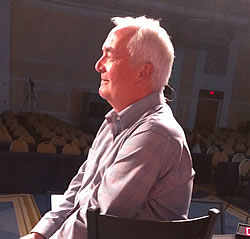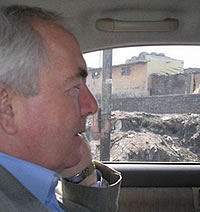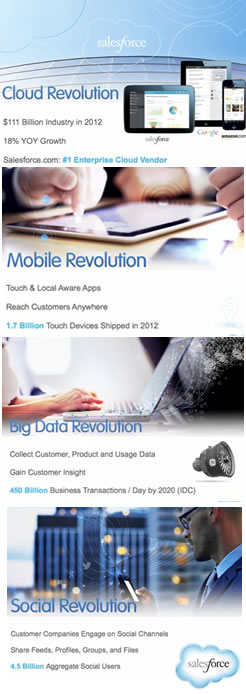
Mobile, social, cloud computing, (Big) data and along with them evolutions regarding the way we work, collaborate and manage information. Trends such as consumerization and the ongoing digitization are just the beginning of what is yet to come. Think about the Internet of Things (IoT) and Artificial Intelligence innovations, for instance.
Bruce Richardson, Salesforce.com’s Chief Enterprise Strategist, on the cloud, the CMO-CIO/IT-business disconnect, big data, social, collaboration and the cloud. Or in other words: a look at the third platform of IT (a term coined by IDC) and some major trends.
Before he started working at Salesforce.com, Bruce Richardson was known as one of the smartest analysts. ZDNet’s Dennis Howlett called his joining Salesforce.com in 2011, a ‘big deal by any standards’. In 2013, Richardson presented a workshop at the Global Directions event of Kodak Alaris in Washington. The title: “The desktop is dead”. The message: the future organization will focus on what matters with an enterprise social network at its core. An interview.
While for some businesses, cloud computing has almost become an evidence, many business are still in the early stages. What are the main reasons holding some of them back?
Bruce Richardson: Ironically, it’s FUD — Fear, Uncertainty and Doubt. This time it’s more internally generated than a vendor maneuver. There are a lot of conservative CIOs at conservative companies that are resisting the ability to transform their companies (note: digital transformation) by adopting modern technologies. Sometimes their fear and uncertainty is fueled by vendors caught on a legacy platform.
IT and the alignment with the business
There often is a de facto disconnect between IT and the business in times where we really can miss that. What’s your take on that? How do we reconnect? Why is there distrust between, let’s say the CMO and CIO in many cases?
Bruce Richardson: Over the last 10-15 years I’ve interviewed hundreds and hundreds of CIOs about their goals for the next year. The answer was always consistent year after year — “My #1 goal is to get closer to the business.” When IT was slow to respond to laptops, wireless networks, and smart-phones, the business went around them and bought them on their own. When IT mandated that when the business wanted to evaluate new applications such as CRM or supply chain it had to look at their ERP vendor’s offering first, the business people again when around them and expensed new cloud offerings on their AmEx.

Today, the goal of IT being aligned with the business is certainly happening. Part of this is being driven by tech-savvy CEOs who want their smart-phones and tablets tied to corporate networks. Part of it is driven by economics and the realization that the business was right — the new products increased productivity at a faster rate and were easier and less expensive to own.
As for CIO-CMO relations, IT used to have to stitch together applications from multiple vendors to try to create end-to-end solutions. This was expensive and required a lot of integration. It wasn’t always easy to prove the ROI. That’s changed dramatically over the last few years.
Which business-critical applications do you see moving most to the cloud now and what do you expect for the future?
Bruce Richardson: The most encouraging trend these days is when you see CTOs and CIOs from Fortune 50 or Fortune 100 companies announce that they have a new “cloud first” strategy for new business technology initiatives. Everything will move to the cloud. We are already seeing companies carve off pieces of their ERP systems (e.g., procurement, order management, analytics) and moving these functions to the cloud. Over the next few years, you will start to see the first wave of large SAP and Oracle users announce the closing of data centers as they move from legacy on-premise ERP to cloud offerings. Very exciting days ahead.
Social and collaboration

What, according to you, are the main evolutions in the social collaboration space and what’s the role of content and information in it all?
Bruce Richardson: Content truly is king. There is increased emphasis on demand shaping and demand sensing using social media to listen and respond. We know so much more about our customers and their intentions. This is creating increased demand for predictive analytics, too.
What are the key success factors to make social collaboration happen in reality and, from the technology viewpoint, what should we now before choosing a solution?
Bruce Richardson: Collaboration works best when it is situational — it’s either embedded in a business process (e.g., our supplier is going to be two days late, let’s collaborate on a plan to meet customer delivery promises and save the quarter) or tied to specific sales or marketing activities. For example, we see sales people truly collaborate when they realize others can help them with a new account, a new industry, or assist them against a specific competitor.
Collaboration works best when it is situational.
Digital is everywhere, the customer journey has changed, the way we do marketing has changed and the buyer is said to increasingly call the shots. We move towards a customer-centric approach, across all channels and touchpoints and with a single customer view as a holy grail with customer experience ranking high on the corporate agenda. Why is that single customer view so important, according to you? Why is the ‘right time right content right place’ message so important?
Bruce Richardson: Customers, especially consumers, have more choices than ever. You have to provide them with a wide range of choices. A study showed that most young people want to buy their firs or next car without ever stepping foot in a dealership or talking to a sales person. Dealers are now creating virtual showrooms that answer all of the questions that the sales person used to do. They will have to do the same in their service departments if they want to win a higher share of the higher margin service and repair business.
Big data and the cloud
What’s your take on big data? What do business executives need to know?
Bruce Richardson: Big data + (predictive) analytics = huge ROI.
Do we need new roles such as Chief Customer Officers, Chief Digital Officers (CDOs), etc. or do we need to move from social business to digital business where business execs truly understand the transformational role of IT and digital, content and customer-centricity and roles are redefined as well as expectations regarding existing functions? Can an exec still afford to not be digital-savvy in an age where everything gets connected?
Bruce Richardson: Every tech change brings the need for new roles. Go back to 1999 and see how many companies created an offshoot with “e” in front of it — eGM, for example, to prove their embracing of e-commerce.
What evolutions do you see happening in the cloud? Hybrid cloud computing, the impact of big data and cloud computing on network infrastructure, security, other things?
Bruce Richardson: Security will always be the top priority, followed by performance, and ease of integration. Hybrid clouds will prove to be a marketing gimmick. Real clouds are multi-tenant for optimal economics and management.
This interview has also been posted on the InformationDynamix blog

